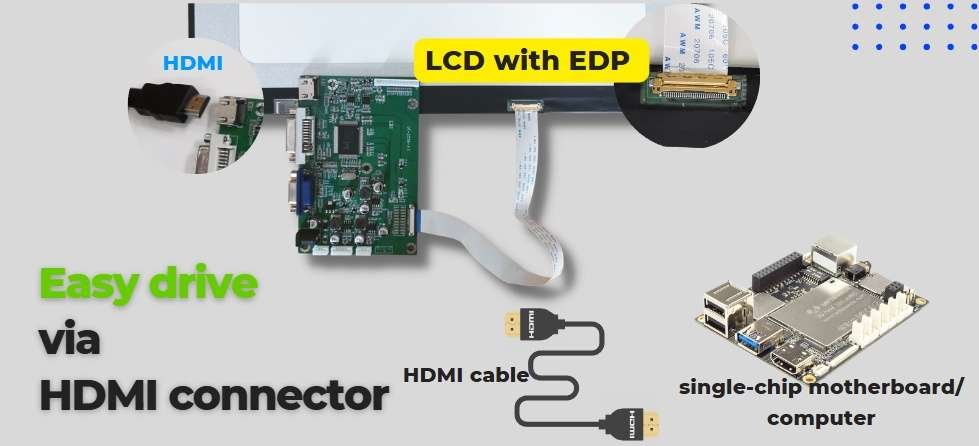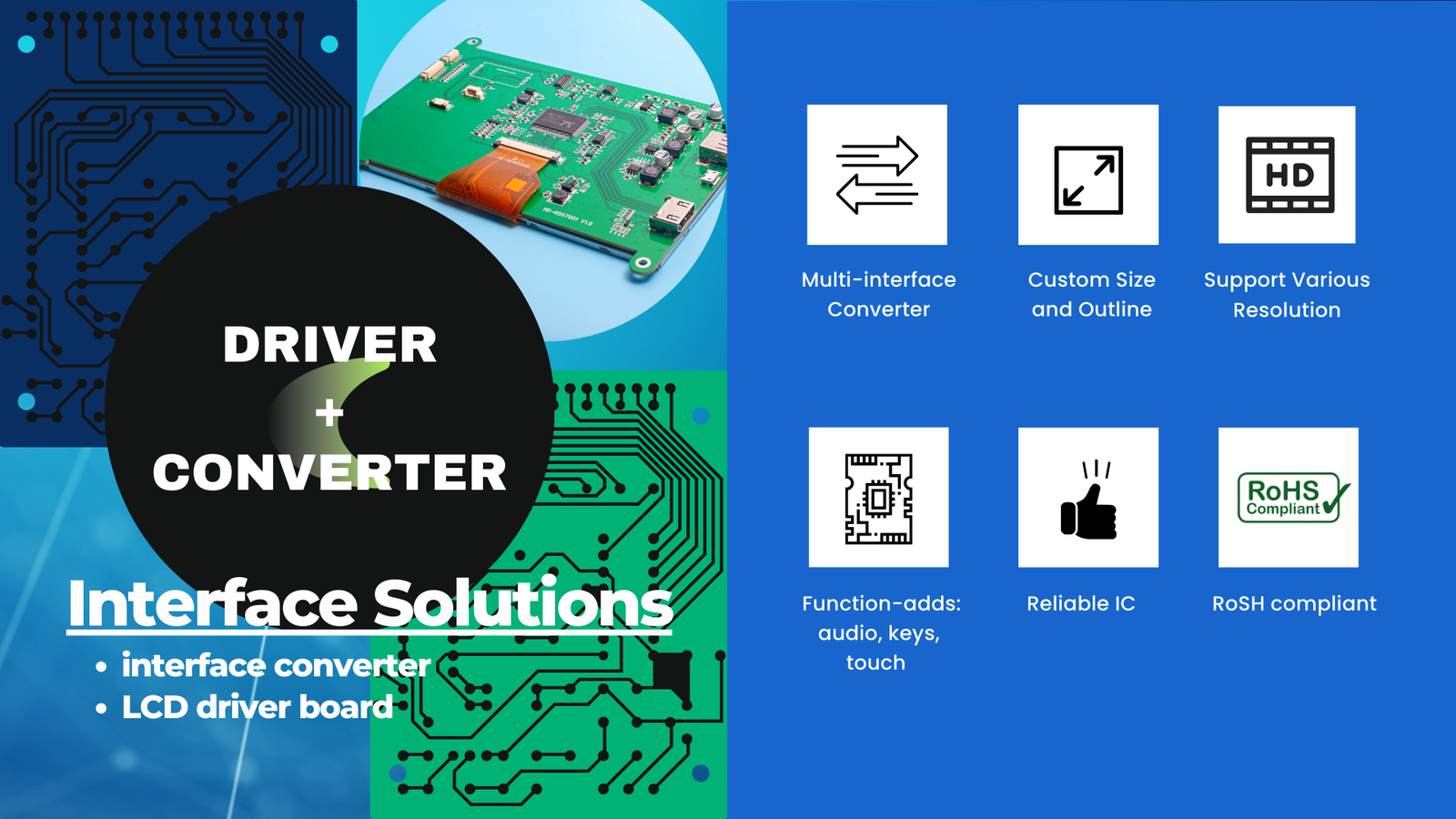LCD controller board, also known as LCD driver board or adapter board, is an electronic circuit board whose main function is to convert the output signals of host devices (such as Windows computers, Android mobile phones, Raspberry Pi, etc.) into signals that the LCD can recognize and drive the LCD to work normally.
In short, the LCD adapter board serves as a “translator” and “bridge” to ensure the smooth transmission of signals between different devices.
Working Principle of LCD Controller Board
The working principle of the controller board is to receive and convert signals.
> Signal Reception
The controller board receives video signals from the main controller or other devices through interfaces (such as HDMI, VGA, LVDS, etc.).
> Signal Processing
The controller board decodes and processes the received signal and converts it into a format suitable for the display. This process may include image scaling, color adjustment, brightness control, etc.
> Signal Output
The processed signal is output to the display through the driver interface of the control board to control the brightness and color of each pixel on the screen to form the final image.
> Real-time Feedback:
Some controller boards also have real-time monitoring and feedback functions, which can automatically adjust the settings according to the display effect to ensure the best display quality.
In general, the process of display signal transmission involves the signal starting from the computer/motherboard, being converted by the controller board, and then entering the display.
Functions of LCD Controller Board
The main functions of the LCD adapter board include the following aspects.
Signal conversion
The LCD controller board can convert the analog or digital signal output by the master device into the specific signal format required by the LCD. This includes but is not limited to signal level conversion, signal format conversion, etc.
Driver and Backlight Control
The controller board has built-in driver chips and control logic, which can drive and control the LCD display according to the instructions of the master device, such as brightness, contrast adjustment, color calibration, etc. It is commonly designed with OSD and an additional controller keypad.
Interface Adaptation
The interfaces of the internal displays, such as RGB, SPI, LVDS, eDP, and MIPI DSI, are not common to the terminal device. The adapter board can convert them to various external common interfaces, such as USB, DVI, DP, VGA, HDMI, etc.
Power Management
The controller board is also responsible for providing a stable power supply for the LCD and performing power management to ensure that the display can obtain the appropriate voltage and current in various working conditions.
Advantages of LCD Controller Board
Flexibility
Lower the limitation of selecting the displays due to interface mismatch issues. In other words, it provides more flexible display screen options to the host devices.
High Performance
Modern control panels usually use high-performance image processing chips, which can quickly process large amounts of data, ensure smooth display effects, and are suitable for high-resolution display requirements.
Energy Saving
It can help the devices focus on energy efficiency and extend their service life.
Easy to Integrate
Not only the interface conversion, the board can also be embedded with another function modulus to provide the integrated solution.
How to Choose an LCD Controller Board?
The right LCD controller board can significantly impact the performance and integration of an LCD display in your project, here are some key factors to consider:
1. LCD Panel Compatibility
- Resolution and Interface: Ensure the controller board matches the resolution and interface (e.g., LVDS, eDP, TTL) of your LCD panel.
- Panel Voltage: Confirm that the board can supply the correct operating voltage for the LCD, as incorrect voltages can damage the screen.
- Power Compatibility: Confirm that the board’s power requirements are compatible with your setup.
- Refresh Rate and Color Depth: Higher refresh rates and color depth are necessary for smooth and vibrant displays, especially in high-quality applications.
2. Display Input Options
- Input Compatibility: Check the controller board’s supported inputs, such as HDMI, VGA, DVI, or DisplayPort, and ensure they align with the device feeding the display (e.g., a computer, media player, or camera).
- Multiple Inputs: If you plan to switch between different video sources, look for boards that support multiple inputs with easy switching options.
3. Backlight Support
- Backlight Driver: Many LCDs need backlight control, so ensure the controller has an integrated backlight driver or supports your backlight type.
4. On-Screen Display (OSD)
- OSD Functionality: For easy user adjustments (like brightness, contrast, and input selection), choose a controller with built-in OSD functionality.
5. Environmental and Application Requirements
- Temperature Range: Industrial and outdoor applications often require controllers that function in a wide temperature range.
- Size and Mounting: Ensure the controller board fits your design constraints, especially for compact applications or where space is limited.
There are many factors to consider when choosing an LCD controller board. However, even though there are benefits from its convenience, the extra board also adds to the cost of the project. If you have any inquiries on the controller board, contact us at tailor@tailorpixels.com.
More to learn about related topics:


